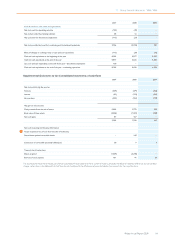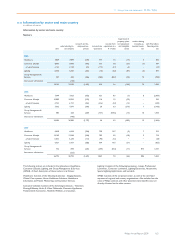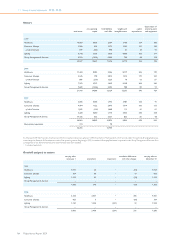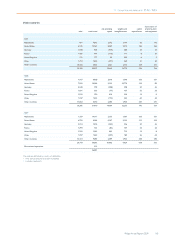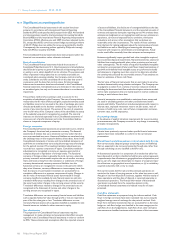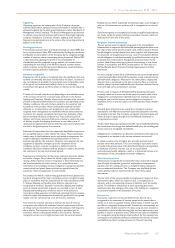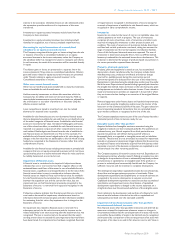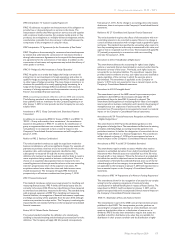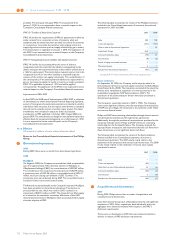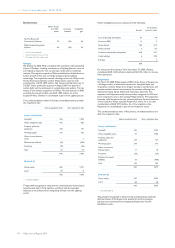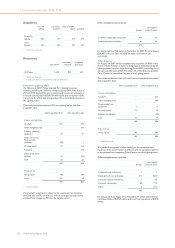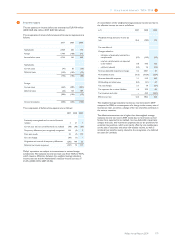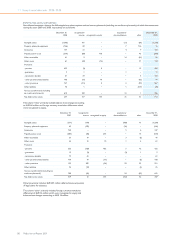Philips 2009 Annual Report Download - page 170
Download and view the complete annual report
Please find page 170 of the 2009 Philips annual report below. You can navigate through the pages in the report by either clicking on the pages listed below, or by using the keyword search tool below to find specific information within the annual report.
use is measured as the present value of future cash flows expected to be
generated by the asset. If the carrying amount of an asset is deemed not
recoverable, an impairment charge is recognized in the amount by
which the carrying amount of the asset exceeds the recoverable
amount. The review for impairment is carried out at the level where
discrete cash flows occur that are independent of other cash flows.
An impairment loss related to intangible assets other than goodwill,
tangible fixed assets, inventories and equity-accounted investees is
reversed if and to the extent there has been a change in the estimates
used to determine the recoverable amount. The loss is reversed only to
the extent that the asset’s carrying amount does not exceed the
carrying amount that would have been determined, net of depreciation
or amortization, if no impairment loss had been recognized. Reversals
of impairment are recognized in the Statements of income.
Goodwill
Goodwill represents the excess of the cost of an acquisition over the
fair value of the Company’s share of the net identifiable assets of the
acquired subsidiary/equity-accounted investee at the date of
acquisition. Goodwill is measured at cost less accumulated impairment
losses. In respect of equity-accounted investees, the carrying amount of
goodwill is included in the carrying amount of the investment.
Impairment of goodwill
Goodwill is not amortized but tested for impairment annually and
whenever impairment indicators require. In most cases the Company
identified its cash generating units as one level below that of an
operating sector. Cash flows at this level are substantially independent
from other cash flows and this is the lowest level at which goodwill is
monitored by the Board of Management. The Company performed and
completed annual impairment tests in the same quarter of all years
presented in the Consolidated statements of income. A goodwill
impairment loss is recognized in the statement of income whenever and
to the extent that the carrying amount of a cash-generating unit exceeds
the recoverable amount of that unit.
Share capital
Incremental costs directly attributable to the issuance of shares are
recognized as a deduction from equity. When share capital recognized
as equity is repurchased, the amount of the consideration paid, including
directly attributable costs, is recognized as a deduction from equity.
Repurchased shares are classified as treasury shares and are presented
as a deduction from stockholders’ equity.
Debt and other liabilities
Debt and liabilities other than provisions are stated at amortized cost.
However, loans that are hedged under a fair value hedge are
remeasured for the changes in the fair value that are attributable to the
risk that is being hedged.
Provisions
Provisions are recognized if, as a result of a past event, the Company has
a present legal or constructive obligation that can be estimated reliably,
and it is probable that an outflow of economic benefits will be required
to settle the obligation.
Provisions are measured at the present value of the expenditures
expected to be required to settle the obligation using a pre-tax discount
rate that reflects current market assessments of the time value of
money and the risks specific to the obligation. The increase in the
provision due to passage of time is recognized as interest expense.
The Company accrues for losses associated with environmental
obligations when such losses are probable and can be estimated reliably.
Measurement of liabilities is based on current legal and constructive
requirements. Liabilities and expected insurance recoveries, if any, are
recorded separately. The carrying amount of liabilities is regularly
reviewed and adjusted for new facts and changes in law.
Restructuring
The provision for restructuring relates to the estimated costs of
initiated reorganizations that have been approved by the Board of
Management, and which involve the realignment of certain parts of the
industrial and commercial organization. When such reorganizations
require discontinuance and/or closure of lines of activities, the
anticipated costs of closure or discontinuance are included in
restructuring provisions. A liability is recognized for those costs only
when the Company has a detailed formal plan for the restructuring and
has raised a valid expectation with those affected that it will carry out
the restructuring by starting to implement that plan or announcing its
main features to those affected by it.
Guarantees
The Company recognizes a liability at the fair value of the obligation at
the inception of a financial guarantee contract. The guarantee is
subsequently measured at the higher of the best estimate of the
obligation or the amount initially recognized.
IFRS accounting standards adopted as from 2009
The Company has adopted the following new and amended IFRSs as of
January 1, 2009. None of these standards and/or interpretations had a
material effect on the Consolidated financial statements of the
Company; however certain of these standards affected the disclosures.
Amendment to IFRS 2 ‘Share-based Payment - Vesting Conditions and
Cancellations’
The amendment to IFRS 2 clarifies the definition of vesting conditions,
introduces the concept of non-vesting conditions, requires non-vesting
conditions to be reflected in grant-date fair value and provides the
accounting treatment for non-vesting conditions and cancellations.
Amendment to IFRS 7 ‘Financial Instruments – Disclosures’
The amendment requires enhanced disclosures about fair value
measurement and liquidity risk. In particular, the amendment requires
disclosure of fair value measurements by level of a fair value
measurement hierarchy. This amendment only results in additional
disclosures to the Consolidated financial statements.
Amendments to IAS 1 ‘Presentation of Financial Statements – A revised
presentation’
The amendments to IAS 1 mainly concern the presentation of changes
in equity, in which changes as a result of the transaction with
shareholders should be presented separately and for which a different
format of the overview of the changes in equity can be selected.
Furthermore, an opening balance sheet of the corresponding period is
presented where restatements have occurred. Philips has chosen to
present all non-owner changes in equity in two statements (a separate
Statement of income and a Statement of comprehensive income). These
amendments only impact the presentation aspects of the Consolidation
financial statements.
Amendments to IAS 32 ‘Financial instruments: Presentation’ and IAS 1
‘Presentation of Financial Statements - Puttable Financial Instruments and
Obligations Arising on Liquidation’
The amendments to IAS 32 and IAS 1 are relevant to entities that have
issued financial instruments that are (i) puttable financial instruments or
(ii) instruments, or components of instruments that impose on the
entity an obligation to deliver to another party a pro-rata share of the
net assets of the entity on liquidation. Under the amended IAS 32,
subject to specified criteria being met, these instruments will be
classified as equity.
Improvements to IFRSs 2008
The improvements published under the IASB’s annual improvement
process are intended to deal with non-urgent, minor amendments to
the standards. Most of the improvements are applicable to the
Company on January 1, 2009, some on January 1, 2010. The
improvements to IFRSs 2008 relate mainly to the following:
• Disclosure requirements: Classification as held-for-sale of the assets
and liabilities of a subsidiary where the parent is committed to a plan
to sell its controlling interest but intends to retain a non-controlling
interest.
• Recognition of government grants arising from government loans at
below-market interest.
• Recognition of advertising and promotional expenditure as an asset
is not permitted beyond the point at which the entity has the right to
access the goods purchased or services received.
• Classification of property under construction for investment
purposes as investment property under IAS 40.
11 Group financial statements 11.11 - 11.11
170 Philips Annual Report 2009



